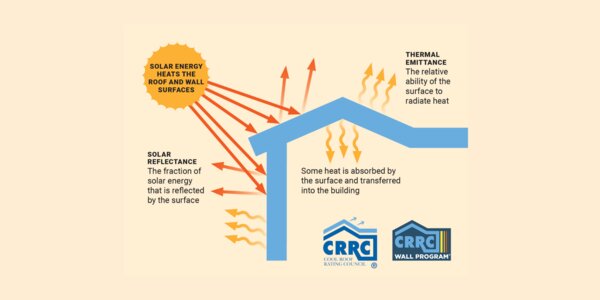The Solar Reflective Index (SRI) and the impact of white roof coatings
In order to quantify and compare the degree surfaces absorb and reflect heat, the SRI was created. Read more about SRI and its relation to our white roof coating Cool-FX in this article.
WHAT IS THE SOLAR REFLECTIVE INDEX?
The Solar Reflective Index (SRI) is a measure that describes a material's ability to reflect sunlight and dissipate heat. It is often used to assess the energy efficiency of building materials, such as roof coverings. SRI values range from 0 to 100, with higher values indicating that the material is better able to reflect sunlight and absorb less heat. The SRI can exceed 100 for more reflective coatings than standard white paint, and can even be negative for black coatings.
A higher SRI value means that the material absorbs less heat, which helps to lower the temperature inside a building and reduce the need for air conditioning. This can result in significant energy savings and increased comfort for the people or animals inside.
HOW IS THE SOLAR REFLECTIVE INDEX CALCULATED?
The Solar Reflective Index is calculated based on two key properties of a material: its solar reflectivity (albedo) and its thermal emissivity. Solar reflectivity measures how much of the sunlight is reflected by the surface, while thermal emissivity indicates how well the material can radiate heat.
To give a concrete example, suppose we have a material with a solar reflectivity of 0.7 and a thermal emissivity of 0.9. These values are entered into a formula that takes into account both direct and diffuse solar radiation to determine the SRI value. Higher solar reflectivity and thermal emissivity result in a higher SRI value. For a full explanation of how the formula works, we suggest that you read Alberto Muscio’s scientific
article about the subject.
Let's compare two surfaces: a white car paint and a white roof coating. White car paint often has a lower SRI value because it has less thermal emissivity compared to specialized white roof coatings. This means that a white roof coating not only reflects more sunlight but is also better at dissipating heat, resulting in a higher SRI and better cooling performance.

HOW DOES THE SRI AFFECT THE CLIMATE OF YOUR BUILDING?
OUR WHITE ROOF COATING COOL-FX.
Cool-FX's Solar Reflective Index has been measured by Themacs Engineering. This is a company that specializes in thermal engineering, thermal analysis, materials characterization and instrumentation. Cool-FX has a SRI that depends on the dilution applied. The results are as follows:
Cool-FX was applied in 3 different dilutions (1:1, 1:2 and 1:3) to see the influence of product concentration on thermal performance.
| Cool-FX 1:1 | Cool-FX 1:2 | Cool-FX 1:3 | |
| SRI (average) | 104 | 104 | 99 |
| Hemispherical emissivity | 0.91 | 0.87 | 0.82 |
*Values of thermal (hemispherical) emittance range from 0 to 1
It’s generally accepted that a SRI value becomes interesting for a roof when it approaches 100 (significant ability to keep the roof surface cold and limit heat absorption).
Cool-FX therefore has a high SRI value despite its ecologically sound composition and, in particular, despite the absence of titanium dioxide in its formulation, making it a reliable candidate as a roof cooling solution.
THE CONVENIENCE OF OUR WHITE ROOF COATING
Our Cool-FX white roof coating offers several advantages that make it the ideal choice for both residential and commercial applications:
- High SRI values: Between 104 to 99, depending on the dilution. Indicating a high level of reflectance.
- Energy-saving: Reduces the need for air conditioning, resulting in lower energy costs.
- Environmentally friendly: Bio-based and biodegradable coating.
- Sustainable: Increases the life of your roofing by reducing exposure to extreme temperatures.
- Easy to apply: Can be applied quickly and easily, without extensive preparations.
Watch our drone footage with heat sensor to see the immediate effect of Cool-FX. You can see how effective our coating works in reducing roof temperatures.